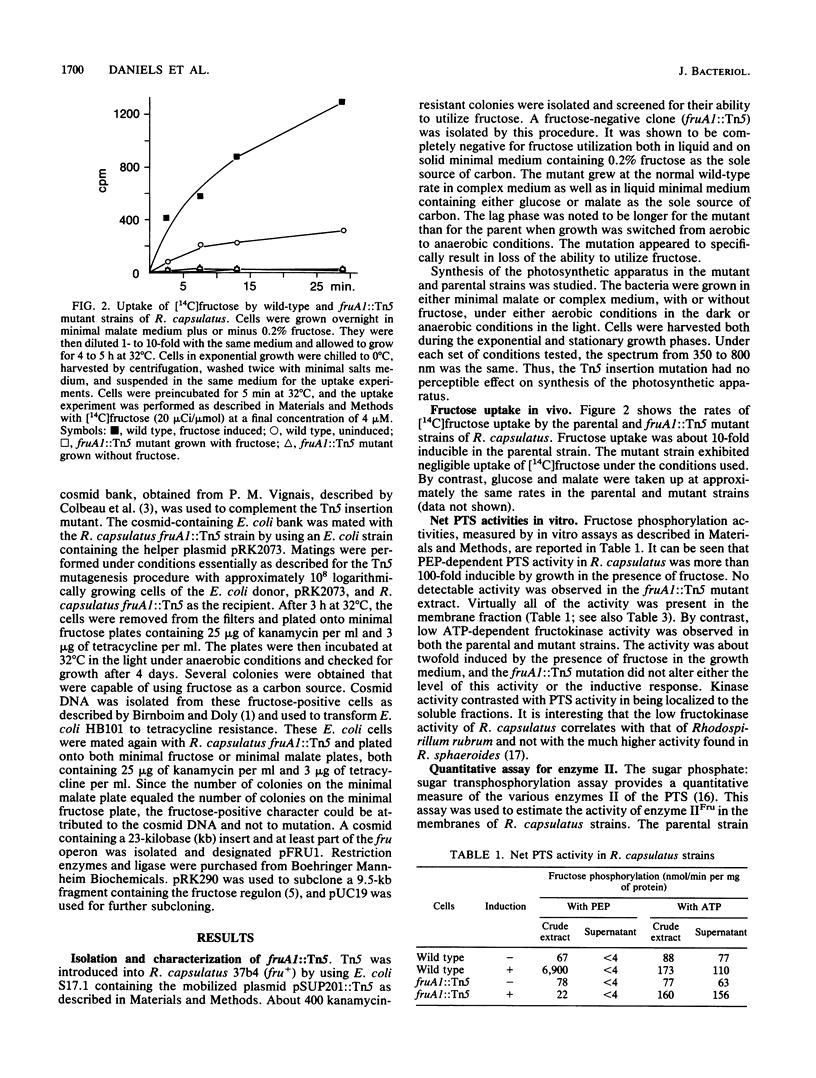Abstract
In photosynthetic bacteria such as members of the genera Rhodospirillum, Rhodopseudomonas, and Rhodobacter a single sugar, fructose, is transported by the phosphotransferase system-catalyzed group translocation mechanism. Previous studies indicated that syntheses of the three fructose catabolic enzymes, the integral membrane enzyme II, the peripheral membrane enzyme I, and the soluble fructose-1-phosphate kinase, are coordinately induced. To characterize the genetic apparatus encoding these enzymes, a Tn5 insertion mutation specifically resulting in a fructose-negative, glucose-positive phenotype was isolated in Rhodobacter capsulatus. The mutant was totally lacking in fructose fermentation, fructose uptake in vivo, phosphoenolpyruvate-dependent fructose phosphorylation in vitro, and fructose 1-phosphate-dependent fructose transphosphorylation in vitro. Extraction of the membrane fraction of wild-type cells with butanol and urea resulted in the preparation of active enzyme II free of contaminating enzyme I activity. This preparation was used to show that the activity of enzyme I was entirely membrane associated in the parent but largely soluble in the mutant, suggesting the presence of an enzyme I-enzyme II complex in the membranes of wild-type cells. The uninduced mutant exhibited measurable activities of both enzyme I and fructose-1-phosphate kinase, which were increased threefold when it was grown in the presence of fructose. Both activities were about 100-fold inducible in the parental strain. Although the Tn5 insertion mutation was polar on enzyme I expression, fructose-1-phosphate kinase activity was enhanced, relative to the parental strain. ATP-dependent fructokinase activity was low, but twofold inducible and comparable in the two strains. A second fru::Tn5 mutant and a chemically induced mutant selected on the basis of xylitol resistance showed pleiotropic loss of enzyme I, enzyme II, and fructose-1-phosphate kinase. These mutants were used to clone the fru regulon by complementing the negative phenotype with a wild-type cosmid bank.
Full text
PDF





Selected References
These references are in PubMed. This may not be the complete list of references from this article.
- Birnboim H. C., Doly J. A rapid alkaline extraction procedure for screening recombinant plasmid DNA. Nucleic Acids Res. 1979 Nov 24;7(6):1513–1523. doi: 10.1093/nar/7.6.1513. [DOI] [PMC free article] [PubMed] [Google Scholar]
- Brouwer M., Elferink M. G., Robillard G. T. Phosphoenolpyruvate-dependent fructose phosphotransferase system of Rhodopseudomonas sphaeroides: purification and physicochemical and immunochemical characterization of a membrane-associated enzyme I. Biochemistry. 1982 Jan 5;21(1):82–88. doi: 10.1021/bi00530a015. [DOI] [PubMed] [Google Scholar]
- Colbeau A., Godfroy A., Vignais P. M. Cloning of DNA fragments carrying hydrogenase genes of Rhodopseudomonas capsulata. Biochimie. 1986 Jan;68(1):147–155. doi: 10.1016/s0300-9084(86)81079-3. [DOI] [PubMed] [Google Scholar]
- Dills S. S., Apperson A., Schmidt M. R., Saier M. H., Jr Carbohydrate transport in bacteria. Microbiol Rev. 1980 Sep;44(3):385–418. doi: 10.1128/mr.44.3.385-418.1980. [DOI] [PMC free article] [PubMed] [Google Scholar]
- Durham D. R., Phibbs P. V., Jr Fractionation and characterization of the phosphoenolpyruvate: fructose 1-phosphotransferase system from Pseudomonas aeruginosa. J Bacteriol. 1982 Feb;149(2):534–541. doi: 10.1128/jb.149.2.534-541.1982. [DOI] [PMC free article] [PubMed] [Google Scholar]
- Fraenkel D. G. The phosphoenolpyruvate-initiated pathway of fructose metabolism in Escherichia coli. J Biol Chem. 1968 Dec 25;243(24):6458–6463. [PubMed] [Google Scholar]
- Lolkema J. S., ten Hoeve-Duurkens R. H., Robillard G. T. The phosphoenolpyruvate-dependent fructose-specific phosphotransferase system in Rhodopseudomonas sphaeroides. Mechanism for transfer of the phosphoryl group from phosphoenolpyruvate to fructose. Eur J Biochem. 1985 Jun 18;149(3):625–631. doi: 10.1111/j.1432-1033.1985.tb08970.x. [DOI] [PubMed] [Google Scholar]
- Postma P. W., Lengeler J. W. Phosphoenolpyruvate:carbohydrate phosphotransferase system of bacteria. Microbiol Rev. 1985 Sep;49(3):232–269. doi: 10.1128/mr.49.3.232-269.1985. [DOI] [PMC free article] [PubMed] [Google Scholar]
- Reiner A. M. Xylitol and D-arabitol toxicities due to derepressed fructose, galactitol, and sorbitol phosphotransferases of Escherichia coli. J Bacteriol. 1977 Oct;132(1):166–173. doi: 10.1128/jb.132.1.166-173.1977. [DOI] [PMC free article] [PubMed] [Google Scholar]
- Roehl R. A., Phibbs P. V., Jr Characterization and genetic mapping of fructose phosphotransferase mutations in Pseudomonas aeruginosa. J Bacteriol. 1982 Mar;149(3):897–905. doi: 10.1128/jb.149.3.897-905.1982. [DOI] [PMC free article] [PubMed] [Google Scholar]
- Saier M. H., Jr Bacterial phosphoenolpyruvate: sugar phosphotransferase systems: structural, functional, and evolutionary interrelationships. Bacteriol Rev. 1977 Dec;41(4):856–871. doi: 10.1128/br.41.4.856-871.1977. [DOI] [PMC free article] [PubMed] [Google Scholar]
- Saier M. H., Jr, Feucht B. U., Mora W. K. Sugar phosphate: sugar transphosphorylation and exchange group translocation catalyzed by the enzyme 11 complexes of the bacterial phosphoenolpyruvate: sugar phosphotransferase system. J Biol Chem. 1977 Dec 25;252(24):8899–8907. [PubMed] [Google Scholar]
- Saier M. H., Jr, Feucht B. U., Roseman S. Phosphoenolpyruvate-dependent fructose phosphorylation in photosynthetic bacteria. J Biol Chem. 1971 Dec 25;246(24):7819–7821. [PubMed] [Google Scholar]
- Saier M. H., Jr, Grenier F. C., Lee C. A., Waygood E. B. Evidence for the evolutionary relatedness of the proteins of the bacterial phosphoenolpyruvate:sugar phosphotransferase system. J Cell Biochem. 1985;27(1):43–56. doi: 10.1002/jcb.240270106. [DOI] [PubMed] [Google Scholar]
- Simoni R. D., Roseman S., Saier M. H., Jr Sugar transport. Properties of mutant bacteria defective in proteins of the phosphoenolpyruvate: sugar phosphotransferase system. J Biol Chem. 1976 Nov 10;251(21):6584–6597. [PubMed] [Google Scholar]


